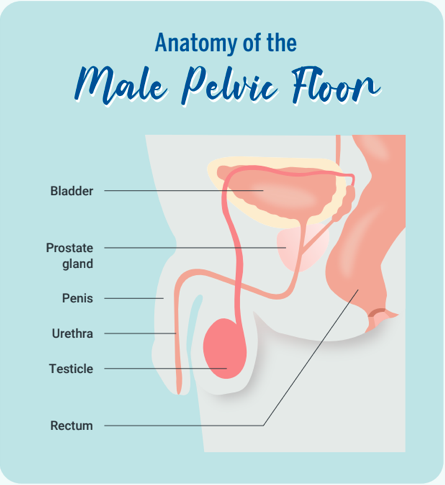News & Articles

Men's Health: Understanding Prostate Health & Changes

It is important to take care of your prostate health as it is related to certain health issues, such as Benign Prostatic Hyperplasia (BPH) and prostate cancer. In Singapore, prostate cancer is the second most common cancer diagnosed in men. Meanwhile, BPH is one of the most common conditions affecting men over the age of 50.
What is the prostate?

The prostate is a walnut-sized gland present only in men. It is located below the bladder and just in front of the rectum. The prostate produces secretion, which nourishes the sperms in the semen.
As the prostate gland tends to grow larger with age, it may squeeze the urethra and cause problems in urination. An infection or a tumour could also enlarge the prostate. The 3 most common prostate problems are inflammation (prostatitis), BPH, and prostate cancer.
Inflammation (prostatitis)
Prostatitis is the inflammation of the prostate gland that may result from a bacterial infection.
Symptoms
- Trouble passing urine
- A burning feeling or pain when passing urine
- Strong, frequent urge to pass urine
- Chills and high fever
- Low back pain or body aches
- Pain in the groin area or behind the scrotum
- Rectal pressure or pain
- Genital and rectal throbbing
Having prostatitis does not increase your risk of any other prostate disease.
Tests and treatment
Several tests, such as Digital Rectal Exam (DRE) and a urine test, can be done to see if you have prostatitis. It is vital to get a correct diagnosis of the exact type of prostatitis so that you can get the right treatment for your condition.
Benign Prostatic Hyperplasia (BPH)
BPH, also known as enlarged prostate, is a common condition that affects the prostate gland in men as they age. “Benign” is a medical term used to describe a non-cancerous growth or condition, while “hyperplasia” refers to abnormal cell growth. As such, BPH is not linked to prostate cancer and does not increase the risk of getting prostate cancer, though the symptoms of both diseases can be similar.
Symptoms
- Trouble starting or having to push to release urine
- Weak or slow urine stream
- Stopping and starting again several times while urinating
- Feeling that the bladder is never fully empty
- Strong urge to pass urine often, especially at night
- A strong or sudden urge to urinate
Tests and treatment
Depending on your symptoms, your doctor may conduct further tests to determine or confirm the diagnosis of BPH. Such tests include a urine flow study, DRE, and cystoscopy.
BPH cannot be cured, but there are several treatment options to relieve its symptoms. In cases where the symptoms are mild, BPH requires no treatment. However, when the symptoms are affecting your quality of life and overall health, consult your doctor for treatment options.
Prostate cancer
Prostate cancer is a tumour that grows in the prostate. Prostate cancers tend to be slow-growing and are typically confined to the prostate gland. However, there also exist aggressive types that can spread to other parts of the body, especially the bones and lymph nodes. Symptoms of prostate cancer are similar to those of BPH mentioned above; other symptoms of prostate cancer include:
- Blood in urine or semen
- Pelvic, back, or hip pain
- Bone pain that refuses to go away
It is important to note that in many cases, there are no symptoms as it can take years before a tumour gets big enough to cause symptoms.
Screening tests
Screening tests for prostate cancer include prostate-specific antigen (PSA) tests. PSA test is a blood test that measures the level of PSA - a protein produced by cells in the prostate gland. The higher the PSA level, the more likely that cancer cells are present. However, an elevated PSA level can also be caused by other factors.
Diagnostic tests
If prostate cancer is suspected, a prostate biopsy will be carried out. This means that a sample tissue from the prostate will be removed to confirm the presence of cancer and the grade of cancer.
During a biopsy, transrectal ultrasound is often used to guide the needles into the part of the prostate gland where the tumour is suspected. MRI guidance may be used to target biopsy sites more accurately in challenging cases.
If prostate cancer is diagnosed, further tests may be conducted to determine the extent of cancer. For instance, MRI prostate, also known as prostate magnetic resonance imaging, can help to determine the local extent of cancer, including the spread of cancer to lymph nodes. MRI prostate is a medical imaging technique used to visualise the prostate gland.
To exclude distant metastases, prostate-specific membrane antigen positron emission tomography (PSMA PET) can be used in high-risk cases where the prostate-specific antigen (PSA) levels are high, or when the tumour is suspected to have a high T stage (indicating a more advanced and potentially aggressive cancer).
Towards a better prostate health
Understanding prostate health and being aware of changes that can occur is crucial for every man. While some changes are a natural part of ageing, others may indicate underlying issues that require attention. By being informed, you can identify the problems and seek professional help from your doctor when needed.
| POSTED IN | Cancer Treatments |
| TAGS | men's cancer, prostatectomy |
| READ MORE ABOUT | Prostate Cancer |
| PUBLISHED | 01 December 2023 |
